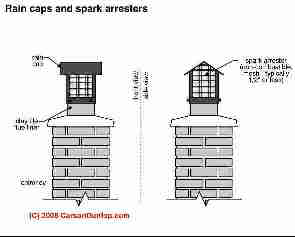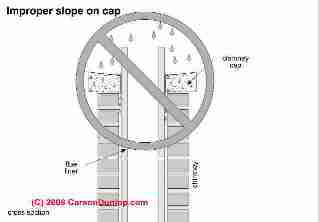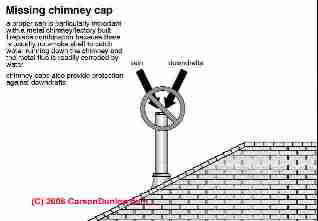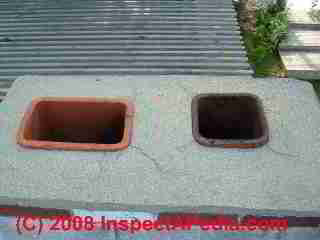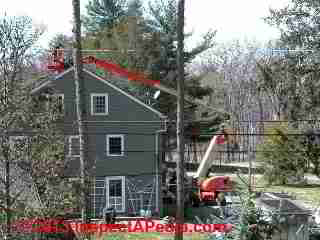 Chimney & Flue Inspection, at the Rooftop
Chimney & Flue Inspection, at the Rooftop
- POST a QUESTION or COMMENT about how to inspect the chimney at the rooftop
Rooftop chimney defects:
This article describes chimney defects that can best be spotted and diagnosed by on-roof access.
These chimney problems include inspection of the chimney cap and crown or top seal, the condition of the uppermost chimney flue, the separation of multiple chimney flues. Additional rooftop chimney inspection details are provided in subsequent sections of this article.
These articles on chimneys and chimney safety provide detailed suggestions describing how to perform a thorough visual inspection of chimneys for safety and other defects. Chimney inspection methods and chimney repair methods are also discussed.
InspectAPedia tolerates no conflicts of interest. We have no relationship with advertisers, products, or services discussed at this website.
- Daniel Friedman, Publisher/Editor/Author - See WHO ARE WE?
Rooftop Chimney Inspection at the Rooftop
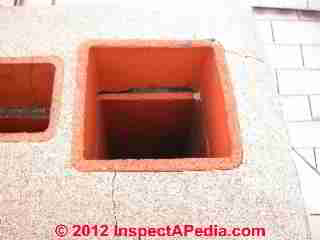 Watch out: Climbing ladders and accessing roofs is inherently dangerous and was the cause of the first home inspector death recorded to have occurred during a home inspection.
Watch out: Climbing ladders and accessing roofs is inherently dangerous and was the cause of the first home inspector death recorded to have occurred during a home inspection.
[Click to enlarge any image]
Home inspectors are not required to climb onto a roof which for any reason the inspector feels is unsafe or too fragile for direct access.
However this article describes describes chimney defects which may be difficult or impossible to detect from a ground-level inspection. If you have not done so,
see CHIMNEY INSPECTION from GROUND CHIMNEY COLLAPSE RISKS, REPAIRS.
Watch out: at the same time, there are many rooftop defects, including potentially costly or dangerous problems, that cannot be discovered by a from-ground-level inspection, even using high powered binoculars. At left is an example: an improperly-constructed chimney flue and cap that risk leaks and hidden damage to the chimney flue. More examples of chimney flue damage are
at Flue Tile Damage in Chimneys.
An on-roof inspection of the chimney allows inspecting the upper portion of the flue lining, cap and roof flashing, chimney top seal or "crown", and it permits a closer inspection of masonry chimneys for cracking or other damage that might not be visible from a more remote "from ground" inspection.
Summary of Inspection Points at Chimney Caps & Crowns
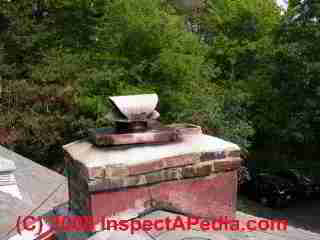 See CHIMNEY CAP & CROWN DEFINITIONS for details about chimney caps & crowns where we detail the various types of covers & terminations found at the top of chimneys and flues & their common defects. There we also cite pertinent chimney top cap / crown building codes & standards.
See CHIMNEY CAP & CROWN DEFINITIONS for details about chimney caps & crowns where we detail the various types of covers & terminations found at the top of chimneys and flues & their common defects. There we also cite pertinent chimney top cap / crown building codes & standards.
Rain Cap: a rain cover on top of a chimney flue designed to keep out rain (which can damage the flue or appliances it vents) and intended to reduce downdrafts in the chimney in windy conditions. The metal cover shown in our photo at left is a metal "rain cap".
This interesting chimney has a metal cap on one flue and not the other. The metal chimney cap looks home-made and perhaps not functional.
Chimney Cap: on a masonry chimney the chimney cap is a pre-cast concrete or poured in place concrete seal around the flue tile (on a modern masonry chimney). In our photo (above left) the chimney cap, also called a mortar cap, is the white concrete visible around the projecting flue tiles at the top of the chimney. Some of us call the mortar cap or concrete chimney cap the chimney crown.
The Masonry Institute of America calls this the "chimney cap" - we're following their terminology.
The purpose of the chimney cap [chimney crown] is to close off the space between the
flue liner and chimney wall, to shed water clear of the chimney and generally prevent moisture entry.
See CHIMNEY "CAP" CROWN / TOP SEAL INSPECTION for a list of defects found at the top seal or "cap" of a masonry chimney.
The rain rain cap has the job of keeping rain and wind down-drafts out of the chimney. The rain cap or hood may also be charged with preventing sparks from leaving the chimney - a fire safety measure shown in Carson Dunlop Associates [at REVIEWERS] Sketch.
See CHIMNEY RAIN CAP / RAIN COVER INSPECTION for details about what goes wrong with the rain cap that may be installed on both masonry flues and metal chimney flues.
[Click to enlarge any image]
The Brick Institute of America (BIA) recommends chimney caps of pre cast or cast-in- place concrete a minimum of 2-inch thick with a projection of 2 1/2-inch beyond the face of the masonry surround so that water shed from the top will not run down the face of the brick.
Chimney cap slope: The chimney "cap" [or crown] should slope away from the flue at a good rate of about 3-inches per foot.
The chimney cap should not be bonded to the flue liner or top of the chimney in order to allow for thermal expansion of the liner. The space between the cap and the flue liner must be closed with a flexible sealant.
Mortar chimney "caps" are prone to cracks and allow water to drain over the face of the chimney masonry leading to spalling, loss of mortar and leakage to the interior spaces. Corrosion at the chimney base cleanout doors are common to those types of chimneys.
Check the chimney top for damaged masonry (or rusted metal), a missing cap, damaged, cracked, or missing top seal or crown on the top of a masonry flue, and here, an important discovery (at least in some jurisdictions) is whether or not the chimney is single wythe or thicker masonry and whether or not the chimney has (or perhaps needs) a chimney liner.
Missing Chimney Rain Cap
If we want proof that people don't spend a lot of time looking at their chimney, ask a home inspector or chimney sweep how often they find that the rain cap or spark arresting chimney cap has been completely lost from a chimney.
As Carson Dunlop's sketch shows, a missing cap invites water damage to the chimney and the equipment it vents, draft problems, and unsafe operation.
Water entering the chimney can cause enough corrosion in a metal flue that the chimney needs replacement.
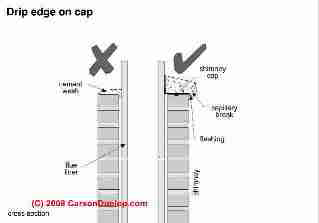
Chimney crown/cap damage or missing drip edge
In Carson dunlop Associates' sketch at left the chimney crown looks recently installed and does not drain past the chimney sides. There has been water damage covered up with painted metal on the chimney side facing us.This chimney needs some safety inspection and probably new caps on the flues.
As Carson Dunlop's sketch shows (left), a good drip edge at the chimney top cap helps reduce water and frost damage to the chimney sides and structure.
Watch out particularly for flat or even in-sloping metal caps on wood-framed chimney chases built around metal chimneys - these are often a source of hidden leaks into the structure and potentially dangerous rust or corrosion damage to fireplace inserts and flues as well as damage to heating equipment.
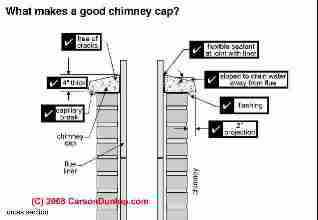
Carson Dunlop Associates' sketch shows some details of good chimney crown/cap construction. The object of these details is to avoid water and frost damage to the flue or to the chimney itself.
Chimney crown/cap history: if a chimney has spent part of its life with no rain cap installed, or if the masonry cap is poorly constructed, there is extra risk of water damage to the flue interior.
In a masonry chimney damage may appear as frost cracking of the upper flue liners or masonry.
In any chimney, there may also be water damage to the heating appliances being vented by that chimney, such as rust, formation of corrosive condensate, or creosote.
Damaged Masonry Chimney Cap or Crown
Chimney Cap/crown: shown here is the concrete seal around the top of a chimney, sealing the upper chimney surface around the projecting chimney flue (clay flue tiles in this photo) in order to close off the space between the flue liner and chimney wall, to shed water clear of the chimney and generally prevent moisture entry.
Here is a chimney with a mortar cap but no rain cap.
The design would have been better if one of the clay flue liners projected several inches higher than its neighbor, and if the concrete cap had been pre-cast or otherwise constructed to give an overhang past the sides of the chimney so that runoff would not wet and damage the brick masonry below.
Installation of this chimney cap would also have been better if there were an expansion gap and sealant permitting the flue tiles to expand without cracking the surrounding concrete cap.
See CHIMNEY CAP & CROWN DEFINITIONS for definitions of chimney rain cap, chimney cap, chimney crown, and for more examples of chimney top defects that may be visible from the ground or from an on-roof inspection.
Question:
(Oct 20, 2011) Brian Matonti said:
when replacing a cracked wash, is the correct way to put copper or galvanized flashing under it? If so, how is put in place?
(Mar 15, 2012) Chuck said:
Have a large open brick chimney, need to run 4 new flue liners and need to cap the large open top. opening is 8' x5' opening brick with parapit tops. The brick has corrossion damage and parapits are not level. How can I support the flues properly?
Reply:
Chuck flues are supported in re-line operations by a bracket or support installed in the chimey base; For masonry-reline repairs the entire liner is adhered to the chimney interior walls. In the latter case it is critical to assure that the strength of the existing chimney can tolerate the wet concrete/mix weight during curing to avoid a blow-out.
...
Continue reading at CHIMNEY TOP MASONRY DAMAGE or select a topic from the closely-related articles below, or see the complete ARTICLE INDEX.
Or see these
Recommended Articles
- CHIMNEY INSPECTION DIAGNOSIS REPAIR - home
- CHIMNEY CAP / CROWN CONSTRUCTION
- CHIMNEY CAP & CROWN DEFINITIONS
- CHIMNEY "CAP" CROWN / TOP SEAL INSPECTION
- CHIMNEY RAIN CAP / RAIN COVER INSPECTION
- CHIMNEY RAIN CAP / RAIN COVER DIY
- CHIMNEY RAIN CAP VENT OPENING SIZE
- CHIMNEY POTS & DECORATIVE TOPS
- CHIMNEY TOP MASONRY DAMAGE
Suggested citation for this web page
CHIMNEY INSPECTION at ROOFTOP at InspectApedia.com - online encyclopedia of building & environmental inspection, testing, diagnosis, repair, & problem prevention advice.
Or see this
INDEX to RELATED ARTICLES: ARTICLE INDEX to CHIMNEYS & FLUES
Or use the SEARCH BOX found below to Ask a Question or Search InspectApedia
Ask a Question or Search InspectApedia
Try the search box just below, or if you prefer, post a question or comment in the Comments box below and we will respond promptly.
Search the InspectApedia website
Note: appearance of your Comment below may be delayed: if your comment contains an image, photograph, web link, or text that looks to the software as if it might be a web link, your posting will appear after it has been approved by a moderator. Apologies for the delay.
Only one image can be added per comment but you can post as many comments, and therefore images, as you like.
You will not receive a notification when a response to your question has been posted.
Please bookmark this page to make it easy for you to check back for our response.
IF above you see "Comment Form is loading comments..." then COMMENT BOX - countable.ca / bawkbox.com IS NOT WORKING.
In any case you are welcome to send an email directly to us at InspectApedia.com at editor@inspectApedia.com
We'll reply to you directly. Please help us help you by noting, in your email, the URL of the InspectApedia page where you wanted to comment.
Citations & References
In addition to any citations in the article above, a full list is available on request.
- Mark Cramer Inspection Services Mark Cramer, Tampa Florida, Mr. Cramer is a past president of ASHI, the American Society of Home Inspectors and is a Florida home inspector and home inspection educator. Mr. Cramer serves on the ASHI Home Inspection Standards. Contact Mark Cramer at: 727-595-4211 mark@BestTampaInspector.com
- John Cranor [Website: /www.house-whisperer.com ] is an ASHI member and a home inspector (The House Whisperer) is located in Glen Allen, VA 23060. He is also a contributor to InspectApedia.com in several technical areas such as plumbing and appliances (dryer vents). Contact Mr. Cranor at 804-873-8534 or by Email: johncranor@verizon.net
- NFPA 211 - 3-1.10 - Relining guide for chimneys
- NFPA 211 - 3-2 - Construction of Masonry Chimneys
- NFPA 211 - 3-3 - Termination Height for chimneys
- NFPA 211 - 3-4 - Clearance from Combustible Material
- NFPA 54 - 7-1 - Venting of Equipment into chimneys
- Brick Institute of America - Flashing Chimneys
Brick Institute of America - Proper Chimney Crowns
Brick Institute of America - Moisture Resistance of Brick - American Gas Association - New Vent Sizing Tables
- Chimney Safety Institute of America - Chimney Fires: Causes, Effects, Evaluation
- National Chimney Sweep Guild - Yellow Pages of Suppliers
- Our recommended books about building & mechanical systems design, inspection, problem diagnosis, and repair, and about indoor environment and IAQ testing, diagnosis, and cleanup are at the InspectAPedia Bookstore. Also see our Book Reviews - InspectAPedia.
- In addition to citations & references found in this article, see the research citations given at the end of the related articles found at our suggested
CONTINUE READING or RECOMMENDED ARTICLES.
- Carson, Dunlop & Associates Ltd., 120 Carlton Street Suite 407, Toronto ON M5A 4K2. Tel: (416) 964-9415 1-800-268-7070 Email: info@carsondunlop.com. Alan Carson is a past president of ASHI, the American Society of Home Inspectors.
Thanks to Alan Carson and Bob Dunlop, for permission for InspectAPedia to use text excerpts from The HOME REFERENCE BOOK - the Encyclopedia of Homes and to use illustrations from The ILLUSTRATED HOME .
Carson Dunlop Associates provides extensive home inspection education and report writing material. In gratitude we provide links to tsome Carson Dunlop Associates products and services.


